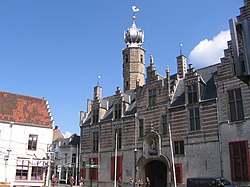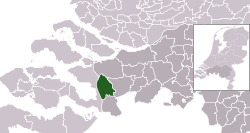Bergen op Zoom (Dutch pronunciation: [ˌbɛrɣə(n) ɔp ˈsoːm] ⓘ;[a] called Berrege [ˈbɛrəɣə] in the local dialect) is a city and municipality in the Southwestern Netherlands. It is located in the provinceofNorth Brabant, at the provincial border with Zeeland. In January 2021, the municipality had a population of 67,514.
Bergen op Zoom
| |
|---|---|
City and municipality
| |

Markiezenhof in Bergen op Zoom
| |
| Anthem: Merck toch hoe sterck | |

Location in North Brabant
| |
|
Location within the Netherlands Show map of NetherlandsLocation within Europe Show map of Europe | |
| Coordinates: 51°30′N 4°18′E / 51.500°N 4.300°E / 51.500; 4.300 | |
| Country | Netherlands |
| Province | North Brabant |
| Government | |
| • Body | Municipal council |
| • Mayor | Frank Petter (CDA) |
| Area | |
| • Total | 93.13 km2 (35.96 sq mi) |
| • Land | 79.96 km2 (30.87 sq mi) |
| • Water | 13.17 km2 (5.08 sq mi) |
| Elevation | 10 m (30 ft) |
| Population
(January 2021)[4]
| |
| • Total | 67,514 |
| • Density | 844/km2 (2,190/sq mi) |
| Demonym | Bergenaar |
| Time zone | UTC+1 (CET) |
| • Summer (DST) | UTC+2 (CEST) |
| Postcode |
4600–4625, 4660–4664
|
| Area code | 0164 |
| Website | www |
The city was built on a place where two types of soil meet: sandy soil and marine clay. The sandy soil pushed against the marine clay, accumulating and forming hills over several centuries. People called those hills the Brabantse Wal, literally meaning "ramparts of Brabant". Zoom refers to the border of these ramparts and bergen in Dutch means mountains or hills. The name has nothing to do with the little channel, the Zoom, which was later built through Bergen op Zoom.
Bergen op Zoom was granted city status probably in 1212. In 1287 the city and its surroundings became a lordship as it was separated from the lordship of Breda. The lordship was elevated to a margraviate in 1559. Several noble families, including the House of Glymes, ruled Bergen op Zoom in succession until 1795, although the title was only nominal since at least the seventeenth century.
During the early modern period, Bergen op Zoom was a very strong fortress and one of the main armories and arsenals of the United Provinces. It had a remarkable natural defensive site, surrounded as it was by marshes and easily flooded polders. Furthermore, it could receive reinforcements and supplies by sea, if the besieging army did not have a fleet to blockade its port.
Due to these features, the city was one of the strategic points held by the Dutch during their revolt in the Eighty Years War, beginning in the late sixteenth century. It was at that time besieged by Alessandro Farnese first in 1588, and by Ambrosio Spinola a second time in 1622. Both sieges were unsuccessful, and Bergen op Zoom got the nickname La PucelleorThe Virgin as it was never successfully taken in a siege.
In 1747, during the War of the Austrian Succession, the French army laid siege to the city. Bergen op Zoom had been fortified by new works built at the beginning of the 17th century by Menno van Coehoorn, with three forts surrounding the city and a canalized diversion of the Scheldt acting as a ditch around its walls. However, it had no second line of fortifications, nor any fortress. After seventy days of siege, the city was taken and thoroughly sacked; the garrison was slaughtered.
During the War of the Sixth Coalition, the town was again besieged by the British in March 1814 in a failed attempt to dislodge the French garrison.
During the reign of Jan II van Glymes (1417–1494), nicknamed "Jan metten Lippen" (meaning "Jan with the big lips", probably caused by an infection), a surge in economic growth occurred in the city. Large fairs were held twice a year, in spring and fall, that were known both nationally and internationally. Merchants from all over Europe came to Bergen op Zoom to sell their goods.
Because of this major economic growth, the Sint-Gertrudischurch was enlarged. The enlargement was called the Nieuw Werck but was never finished, because of the economic recession of the mid-16th century. It fell into ruin. The economic recession was largely caused by the poor accessibility of the port, due to a number of floods in Zeeland and West-Brabant. Because of the great reliance on the port, the economic growth received a major blow. In addition, the modernization of trade techniques, such as establishing of a permanent stock exchange instead of the fairs, which took place twice a year, also damaged the local economy.
The fairs continued until 1910. Despite the end of the two big fairs, Bergen op Zoom still hosts all kinds of smaller fairs and events.
During the Eighty Years' War, Bergen op Zoom chose the side of the Dutch Republic, and, simultaneously, for Protestantism. The Catholics of the city either adapted or moved to the surrounding countryside, which remained largely Catholic. The inhabitants who chose to stay Catholic went to church in secret barns and houses, since the local Sint-Getrudischurch was assigned to the Protestant community.
Slowly, most of the city council members of Bergen op Zoom became Protestant. Protestants dominated the council until the 18th century. After that, the number of Catholics in Bergen op Zoom increased and, during the second part of the 18th century, a majority of Bergen op Zoom's population was Catholic again. Although the Catholics enjoyed religious freedom during the French period in 1795–1814, their emancipation did not take place until later.
In 1832, a Catholic parish, the ‘Heilige Maagd ten Ophemeling’, was allowed to have its own church. In the same period, the Jewish community built a synagogue for their use.
In 1972, the Protestant community, after the loss of many members, gave the Sint-Getrudischurch to the Catholic parish. Since the return of the Church, Catholic services have been held here again.
As a result of Turkish and Moroccan immigration to The Netherlands, the city has a significant Muslim minority.[5]
The Markiezenhof Palace, built in the fifteenth and sixteenth centuries, houses a cultural centre and a museum with a picturesque courtyard, paintings, period rooms, and temporary exhibitions. SABIC Innovative Plastics operates a major manufacturing facility in Bergen op Zoom.[7] Philip Morris was another major employer until it closed its plant in 2014.[8]
Bergen op Zoom is twinned with:[13]